Get free scan and check if your device is infected.
Remove it nowTo use full-featured product, you have to purchase a license for Combo Cleaner. Seven days free trial available. Combo Cleaner is owned and operated by RCS LT, the parent company of PCRisk.com.
What is MacOSDefender?
MacOSDefender is a rogue application designed to take control of installed web browsers. Developers proliferate MacOSDefender using a deceptive marketing method called "bundling", and thus it often infiltrates systems without permission.
Research shows that, after hijacking browsers, MacOSDefender causes unwanted redirects and might also record various sensitive information.
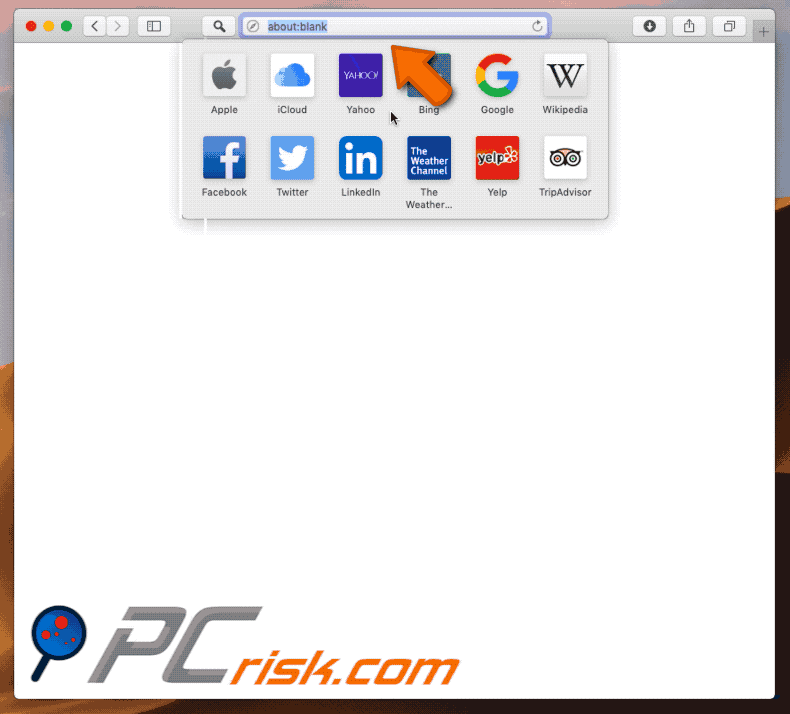
MacOSDefender is related to another browser-hijacking app called Genieo. After successful infiltration, MacOSDefender displays a pop-up message asking users to grant access to their web browsers (e.g., Safari). The rogue app process runs continually, since MacOSDefender is designed to restart every time it is terminated by the user.
After infiltrating the system, MacOSDefender forces visits to a number of dubious sites when users search via the URL bar or simply open a new browser tab. This app is designed to cause the following redirect chain: google.com->goto-searchitnow.global.ssl.fastly.net->my-search.com->searchroute-1560352588.us-west-2.elb.amazonaws.com->alphashoppers.co.
Therefore, after entering a search query, users end up searching via alphashoppers.co (a fake search engine). These redirects significantly diminish the browsing experience (users are redirected against their will). Browser-hijacking applications also record data relating to users' web browsing activity.
Collected data (IP addresses, website URLs visited, pages viewed, search queries, etc.) usually includes personal details that developers share with third parties (potentially, cyber criminals). These people misuse private information to generate revenue. Therefore, information tracking can lead to serious privacy issues or even identity theft.
The MacOSDefender application file is stored in the "/Users/test/Library/Application Support/.dir/MacOSDefender.app/Contents/MacOS/" directory. Furthermore, its associated process ("MacOSDefender.app") can be seen in Activity Monitor. Therefore, determining MacOSDefender's presence is straightforward.
If you observe MacOSDefender's process in the Activity Monitor, identify associated files present, and encounter unwanted redirects, immediately scan the system with Combo Cleaner Antivirus for Windows and eliminate this threat.
| Name | MacOSDefender malware |
| Threat Type | Mac malware, Mac virus |
| Symptoms | Your Mac became slower than normal, you see unwanted pop-up ads, you get redirected to shady websites. |
| Distribution methods | Deceptive pop-up ads, free software installers (bundling), fake flash player installers, torrent file downloads. |
| Damage | Internet browsing tracking (potential privacy issues), displaying of unwanted ads, redirects to shady websites, loss of private information. |
| Malware Removal (Windows) |
To eliminate possible malware infections, scan your computer with legitimate antivirus software. Our security researchers recommend using Combo Cleaner. Download Combo CleanerTo use full-featured product, you have to purchase a license for Combo Cleaner. 7 days free trial available. Combo Cleaner is owned and operated by RCS LT, the parent company of PCRisk.com. |
As mentioned above, MacOSDefender is categorized as a browser hijacker. Therefore, it shares similarities with other similar apps, such as Any Search Manager, Lavradoor, etc. These apps offer "useful functionality", but few provide the functions promised. Most serve only one purpose: to generate revenue for the developers.
Rather than giving any real value for regular users, these unwanted applications modify browser options (thereby promoting rogue sites) and record user-system information. In doing so, they diminish the browsing experience and pose a direct threat to your privacy and browsing safety (promoted websites might contain malicious content).
How did MacOSDefender install on my computer?
Developers promote MacOSDefender using the "bundling" method - stealth installation of third party programs with regular software. Developers are not honest enough to adequately disclose installation of these applications. Therefore, they are hidden within "Custom/Advanced" settings (or other sections) of the download/installation processes.
Furthermore, many users are likely rush download/installation processes and skip steps. Behavior that often leads to inadvertent installation of unwanted programs - users expose their systems to risk of various infections and compromise their privacy.
How to avoid installation of potentially unwanted applications?
To prevent this situation, be very cautious when browsing the web and downloading/installing software. Select "Custom/Advanced" settings and carefully analyze all steps of the download/installation procedures. Opt-out of additionally-included apps and decline offers to download/install them.
We also advise you to avoid using third party downloaders/installers, since most are promoted using rogue software. Apps should be downloaded from official sources only, using direct download links.
Potentially unwanted applications are also distributed using intrusive advertisements that redirect to malicious sites and execute scripts designed to download/install malware. Most are delivered by adware-type applications. Thus, if you encounter these dubious redirects, immediately remove all suspicious applications and browser plug-ins.
The main reasons for computer infections are poor knowledge and careless behavior. Key to safety is caution. If your computer is already infected with browser hijackers, we recommend running a scan with Combo Cleaner Antivirus for Windows to automatically eliminate them.
MacOSDefender displays a pop-up asking users to grant access to their web browsers:
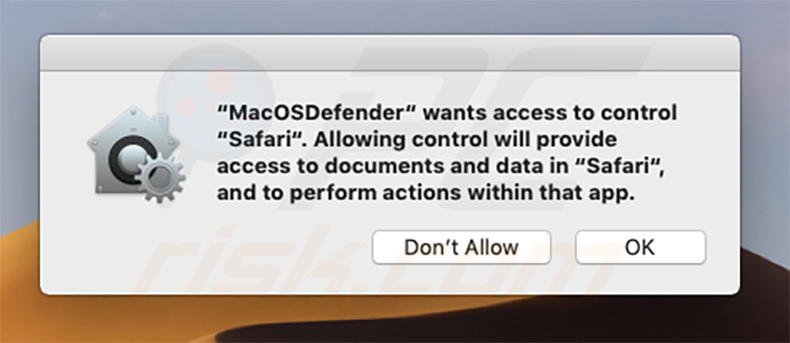
Text presented within this pop-up:
"MacOSDefender.app" wants access to control "Safari.app". Allowing control will provide access to documents and data in "Safari.app", and to perform actions within that app.
MacOSDefender process in Mac Activity Monitor:
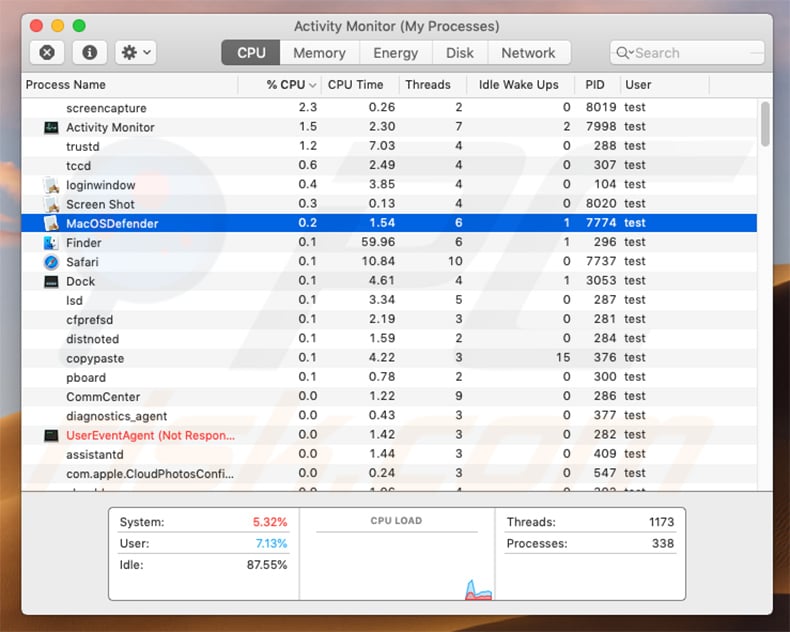
MacOSDefender application in the system ("/Users/test/Library/Application Support/.dir/MacOSDefender.app/Contents/MacOS/") directory:
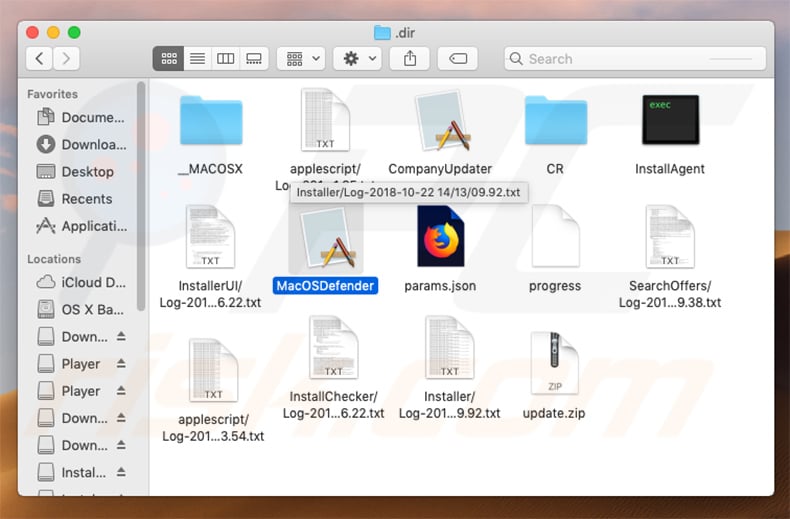
Instant automatic malware removal:
Manual threat removal might be a lengthy and complicated process that requires advanced IT skills. Combo Cleaner is a professional automatic malware removal tool that is recommended to get rid of malware. Download it by clicking the button below:
DOWNLOAD Combo CleanerBy downloading any software listed on this website you agree to our Privacy Policy and Terms of Use. To use full-featured product, you have to purchase a license for Combo Cleaner. 7 days free trial available. Combo Cleaner is owned and operated by RCS LT, the parent company of PCRisk.com.
Quick menu:
- What is MacOSDefender?
- STEP 1. Remove PUA related files and folders from OSX.
- STEP 2. Remove rogue extensions from Safari.
- STEP 3. Remove rogue add-ons from Google Chrome.
- STEP 4. Remove potentially unwanted plug-ins from Mozilla Firefox.
Video showing how to eliminate MacOSDefender virus using Combo Cleaner:
Potentially unwanted applications removal:
Remove potentially unwanted applications from your "Applications" folder:

Click the Finder icon. In the Finder window, select “Applications”. In the applications folder, look for “MPlayerX”,“NicePlayer”, or other suspicious applications and drag them to the Trash. After removing the potentially unwanted application(s) that cause online ads, scan your Mac for any remaining unwanted components.
DOWNLOAD remover for malware infections
Combo Cleaner checks if your computer is infected with malware. To use full-featured product, you have to purchase a license for Combo Cleaner. 7 days free trial available. Combo Cleaner is owned and operated by RCS LT, the parent company of PCRisk.com.
Remove adware-related files and folders

Click the Finder icon, from the menu bar. Choose Go, and click Go to Folder...
 Check for adware generated files in the /Library/LaunchAgents/ folder:
Check for adware generated files in the /Library/LaunchAgents/ folder:

In the Go to Folder... bar, type: /Library/LaunchAgents/

In the "LaunchAgents" folder, look for any recently-added suspicious files and move them to the Trash. Examples of files generated by adware - "installmac.AppRemoval.plist", "myppes.download.plist", "mykotlerino.ltvbit.plist", "kuklorest.update.plist", etc. Adware commonly installs several files with the exact same string.
 Check for adware generated files in the ~/Library/Application Support/ folder:
Check for adware generated files in the ~/Library/Application Support/ folder:

In the Go to Folder... bar, type: ~/Library/Application Support/

In the "Application Support" folder, look for any recently-added suspicious folders. For example, "MplayerX" or "NicePlayer", and move these folders to the Trash.
 Check for adware generated files in the ~/Library/LaunchAgents/ folder:
Check for adware generated files in the ~/Library/LaunchAgents/ folder:

In the Go to Folder... bar, type: ~/Library/LaunchAgents/

In the "LaunchAgents" folder, look for any recently-added suspicious files and move them to the Trash. Examples of files generated by adware - "installmac.AppRemoval.plist", "myppes.download.plist", "mykotlerino.ltvbit.plist", "kuklorest.update.plist", etc. Adware commonly installs several files with the exact same string.
 Check for adware generated files in the /Library/LaunchDaemons/ folder:
Check for adware generated files in the /Library/LaunchDaemons/ folder:

In the "Go to Folder..." bar, type: /Library/LaunchDaemons/

In the "LaunchDaemons" folder, look for recently-added suspicious files. For example "com.aoudad.net-preferences.plist", "com.myppes.net-preferences.plist", "com.kuklorest.net-preferences.plist", "com.avickUpd.plist", etc., and move them to the Trash.
 Scan your Mac with Combo Cleaner:
Scan your Mac with Combo Cleaner:
If you have followed all the steps correctly, your Mac should be clean of infections. To ensure your system is not infected, run a scan with Combo Cleaner Antivirus. Download it HERE. After downloading the file, double click combocleaner.dmg installer. In the opened window, drag and drop the Combo Cleaner icon on top of the Applications icon. Now open your launchpad and click on the Combo Cleaner icon. Wait until Combo Cleaner updates its virus definition database and click the "Start Combo Scan" button.

Combo Cleaner will scan your Mac for malware infections. If the antivirus scan displays "no threats found" - this means that you can continue with the removal guide; otherwise, it's recommended to remove any found infections before continuing.

After removing files and folders generated by the adware, continue to remove rogue extensions from your Internet browsers.
Remove malicious extensions from Internet browsers
 Remove malicious Safari extensions:
Remove malicious Safari extensions:

Open the Safari browser, from the menu bar, select "Safari" and click "Preferences...".

In the preferences window, select "Extensions" and look for any recently-installed suspicious extensions. When located, click the "Uninstall" button next to it/them. Note that you can safely uninstall all extensions from your Safari browser - none are crucial for regular browser operation.
- If you continue to have problems with browser redirects and unwanted advertisements - Reset Safari.
 Remove malicious extensions from Google Chrome:
Remove malicious extensions from Google Chrome:

Click the Chrome menu icon ![]() (at the top right corner of Google Chrome), select "More Tools" and click "Extensions". Locate all recently-installed suspicious extensions, select these entries and click "Remove".
(at the top right corner of Google Chrome), select "More Tools" and click "Extensions". Locate all recently-installed suspicious extensions, select these entries and click "Remove".

- If you continue to have problems with browser redirects and unwanted advertisements - Reset Google Chrome.
 Remove malicious extensions from Mozilla Firefox:
Remove malicious extensions from Mozilla Firefox:

Click the Firefox menu ![]() (at the top right corner of the main window) and select "Add-ons and themes". Click "Extensions", in the opened window locate all recently-installed suspicious extensions, click on the three dots and then click "Remove".
(at the top right corner of the main window) and select "Add-ons and themes". Click "Extensions", in the opened window locate all recently-installed suspicious extensions, click on the three dots and then click "Remove".

- If you continue to have problems with browser redirects and unwanted advertisements - Reset Mozilla Firefox.
How to remove MacOSDefender browser hijacker from Mac?
What is MacOSDefender?
MacOSDefender is a rogue application designed to take control of installed web browsers. Developers proliferate MacOSDefender using a deceptive marketing method called "bundling", and thus it often infiltrates systems without permission. Research shows that, after hijacking browsers, MacOSDefender causes unwanted redirects and might also record various sensitive information.

MacOSDefender is related to another browser-hijacking app called Genieo. After successful infiltration, MacOSDefender displays a pop-up message asking users to grant access to their web browsers (e.g., Safari). The rogue app process runs continually, since MacOSDefender is designed to restart every time it is terminated by the user.
After infiltrating the system, MacOSDefender forces visits to a number of dubious websites when users search via the URL bar or simply open a new browser tab. This app is designed to cause the following redirect chain: google.com->goto-searchitnow.global.ssl.fastly.net->my-search.com->searchroute-1560352588.us-west-2.elb.amazonaws.com->alphashoppers.co.
Therefore, after entering a search query, users end up searching via alphashoppers.co (a fake search engine). These redirects significantly diminish the browsing experience (users are redirected against their will). Browser-hijacking applications also record data about relating to users' web browsing activity.
Collected data (IP addresses, website URLs visited, pages viewed, search queries, etc.) usually includes personal details that developers share with third parties (potentially, cyber criminals). These people misuse private information to generate revenue. Therefore, information tracking can lead to serious privacy issues or even identity theft.
The MacOSDefender application file is stored in the "/Users/test/Library/Application Support/.dir/MacOSDefender.app/Contents/MacOS/" directory. Furthermore, its associated process ("MacOSDefender.app") can be seen in Activity Monitor. Therefore, determining MacOSDefender's presence is straightforward.
If you observe MacOSDefender's process in the Activity Monitor, identify associated files present, and encounter unwanted redirects, immediately scan the system with Combo Cleaner Antivirus for Windows and eliminate this threat.
| Name | MacOSDefender malware |
| Threat Type | Mac malware, Mac virus |
| Symptoms | Your Mac became slower than normal, you see unwanted pop-up ads, you get redirected to shady websites. |
| Distribution methods | Deceptive pop-up ads, free software installers (bundling), fake flash player installers, torrent file downloads. |
| Damage | Internet browsing tracking (potential privacy issues), displaying of unwanted ads, redirects to shady websites, loss of private information. |
| Malware Removal (Windows) |
To eliminate possible malware infections, scan your computer with legitimate antivirus software. Our security researchers recommend using Combo Cleaner. Download Combo CleanerTo use full-featured product, you have to purchase a license for Combo Cleaner. 7 days free trial available. Combo Cleaner is owned and operated by RCS LT, the parent company of PCRisk.com. |
As mentioned above, MacOSDefender is categorized as a browser hijacker. Therefore, it shares similarities with other similar apps, such as Any Search Manager, Lavradoor, etc. These apps offer "useful functionality", but few provide the functions promised. Most serve only one purpose: to generate revenue for the developers.
Rather than giving any real value for regular users, these unwanted applications modify browser options (thereby promoting rogue sites) and record user-system information. In doing so, they diminish the browsing experience and pose a direct threat to your privacy and browsing safety (promoted websites might contain malicious content).
How did MacOSDefender install on my computer?
Developers promote MacOSDefender using the "bundling" method - stealth installation of third party programs with regular software. Developers are not honest enough to adequately disclose installation of these applications. Therefore, they are hidden within "Custom/Advanced" settings (or other sections) of the download/installation processes.
Furthermore, many users are likely rush download/installation processes and skip steps. Behavior that often leads to inadvertent installation of unwanted programs - users expose their systems to risk of various infections and compromise their privacy.
How to avoid installation of potentially unwanted applications?
To prevent this situation, be very cautious when browsing the web, and downloading/installing software. Always select "Custom/Advanced" settings and carefully analyze all steps of the download/installation procedures. While doing so, opt-out additionally-included apps and decline offers to download/install them.
We also advise to avoid using third party downloaders/installers, since most are promoted using rogue software. apps should be downloaded from official sources only, using a direct download links. Potentially unwanted applications are also often distributed using intrusive advertisements which redirect to malicious sites, and execute scripts designed to download/install malware.
Most are delivered by adware-type applications, Thus, if you encounter dubious redirects should immediately remove all suspicious applications and browser plug-ins. The main reasons for computer infections are poor knowledge and careless behavior.
Key to safety is caution. If your computer is already infected with browser hijackers, we recommend running a scan with Combo Cleaner Antivirus for Windows to automatically eliminate them.
MacOSDefender displays a pop-up asking users to grant access to web browsers:

Text presented within this pop-up:
"MacOSDefender.app" wants access to control "Safari.app". Allowing control will provide access to documents and data in "Safari.app", and to perform actions within that app.
MacOSDefender's process in Mac Activity Monitor:

MacOSDefender application in the system ("/Users/test/Library/Application Support/.dir/MacOSDefender.app/Contents/MacOS/" directory):

Instant automatic malware removal:
Manual threat removal might be a lengthy and complicated process that requires advanced IT skills. Combo Cleaner is a professional automatic malware removal tool that is recommended to get rid of malware. Download it by clicking the button below:
DOWNLOAD Combo CleanerBy downloading any software listed on this website you agree to our Privacy Policy and Terms of Use. To use full-featured product, you have to purchase a license for Combo Cleaner. 7 days free trial available. Combo Cleaner is owned and operated by RCS LT, the parent company of PCRisk.com.
Quick menu:
- What is MacOSDefender?
- STEP 1. Remove PUA related files and folders from OSX.
- STEP 2. Remove rogue extensions from Safari.
- STEP 3. Remove rogue add-ons from Google Chrome.
- STEP 4. Remove potentially unwanted plug-ins from Mozilla Firefox.
Video showing how to eliminate MacOSDefender virus using Combo Cleaner:
Potentially unwanted applications removal:
Remove potentially unwanted applications from your "Applications" folder:

Click the Finder icon. In the Finder window, select “Applications”. In the applications folder, look for “MPlayerX”,“NicePlayer”, or other suspicious applications and drag them to the Trash. After removing the potentially unwanted application(s) that cause online ads, scan your Mac for any remaining unwanted components.
DOWNLOAD remover for malware infections
Combo Cleaner checks if your computer is infected with malware. To use full-featured product, you have to purchase a license for Combo Cleaner. 7 days free trial available. Combo Cleaner is owned and operated by RCS LT, the parent company of PCRisk.com.
Remove browser hijacker-related files and folders

Click the Finder icon from the menu bar. Choose Go, and click Go to Folder...
 Check for browser hijacker generated files in the /Library/LaunchAgents/ folder:
Check for browser hijacker generated files in the /Library/LaunchAgents/ folder:

In the Go to Folder... bar, type: /Library/LaunchAgents/

In the "LaunchAgents" folder, look for any recently-added suspicious files and move them to the Trash. Examples of files generated by browser hijackers - "installmac.AppRemoval.plist", "myppes.download.plist", "mykotlerino.ltvbit.plist", "kuklorest.update.plist", etc. Browser hijacker commonly installs several files with the exact same string.
 Check for browser hijacker generated files in the ~/Library/Application Support/ folder:
Check for browser hijacker generated files in the ~/Library/Application Support/ folder:

In the Go to Folder... bar, type: ~/Library/Application Support/

In the "Application Support" folder, look for any recently-added suspicious folders. For example, "MplayerX" or "NicePlayer", and move these folders to the Trash.
 Check for browser hijacker generated files in the ~/Library/LaunchAgents/ folder:
Check for browser hijacker generated files in the ~/Library/LaunchAgents/ folder:

In the Go to Folder... bar, type: ~/Library/LaunchAgents/

In the "LaunchAgents" folder, look for any recently-added suspicious files and move them to the Trash. Examples of files generated by browser hijackers - "installmac.AppRemoval.plist", "myppes.download.plist", "mykotlerino.ltvbit.plist", "kuklorest.update.plist", etc. Browser hijacker commonly installs several files with the exact same string.
 Check for browser hijacker generated files in the /Library/LaunchDaemons/ folder:
Check for browser hijacker generated files in the /Library/LaunchDaemons/ folder:

In the "Go to Folder..." bar, type: /Library/LaunchDaemons/

In the "LaunchDaemons" folder, look for recently-added suspicious files. For example "com.aoudad.net-preferences.plist", "com.myppes.net-preferences.plist", "com.kuklorest.net-preferences.plist", "com.avickUpd.plist", etc., and move them to the Trash.
 Scan your Mac with Combo Cleaner:
Scan your Mac with Combo Cleaner:
If you have followed all the steps correctly, your Mac should be clean of infections. To ensure your system is not infected, run a scan with Combo Cleaner Antivirus. Download it HERE. After downloading the file, double click combocleaner.dmg installer. In the opened window, drag and drop the Combo Cleaner icon on top of the Applications icon. Now open your launchpad and click on the Combo Cleaner icon. Wait until Combo Cleaner updates its virus definition database and click the "Start Combo Scan" button.

Combo Cleaner will scan your Mac for malware infections. If the antivirus scan displays "no threats found" - this means that you can continue with the removal guide; otherwise, it's recommended to remove any found infections before continuing.

After removing files and folders generated by the browser hijackers, continue to remove rogue extensions from your Internet browsers.
Remove browser hijackers from Internet browsers
 Remove Safari browser hijackers:
Remove Safari browser hijackers:

Open the Safari browser, from the menu bar, select "Safari" and click "Preferences...".

In the preferences window, select "Extensions" and look for any recently-installed suspicious extensions. When located, click the "Uninstall" button next to it/them. Note that you can safely uninstall all extensions from your Safari browser - none are crucial for regular browser operation.
Change your homepage:
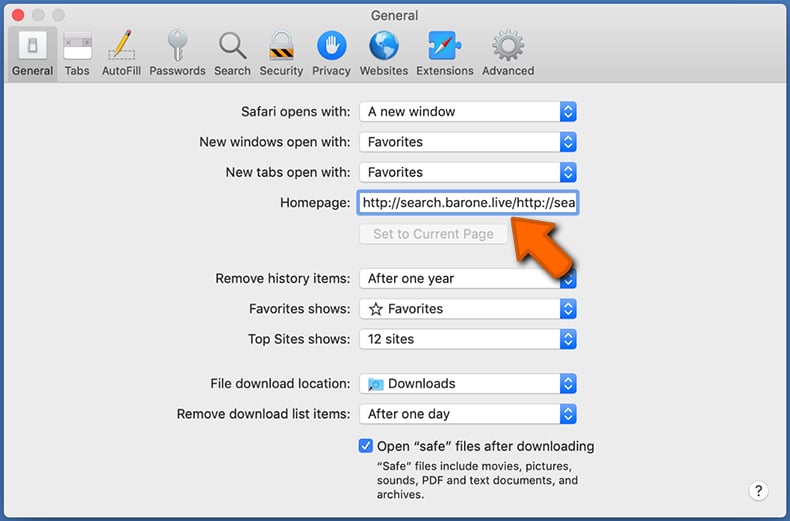
In the "Preferences" window, select the "General" tab. To set your homepage, type the preferred website URL (for example: www.google.com) in the Homepage field. You can also click the "Set to Current Page" button if you wish to set your homepage to the website you are currently visiting.
Change your default search engine:

In the "Preferences" window, select the "Search" tab. Here you will find a drop-down menu labeled "Search engine:" Simply select your preferred search engine from the drop-down list.
- If you continue to have problems with browser redirects and unwanted advertisements - Reset Safari.
 Remove Google Chrome browser hijackers:
Remove Google Chrome browser hijackers:

Click the Chrome menu icon ![]() (at the top right corner of Google Chrome), select "More Tools" and click "Extensions". Locate all recently-installed suspicious extensions, select these entries and click "Remove".
(at the top right corner of Google Chrome), select "More Tools" and click "Extensions". Locate all recently-installed suspicious extensions, select these entries and click "Remove".

Change your homepage
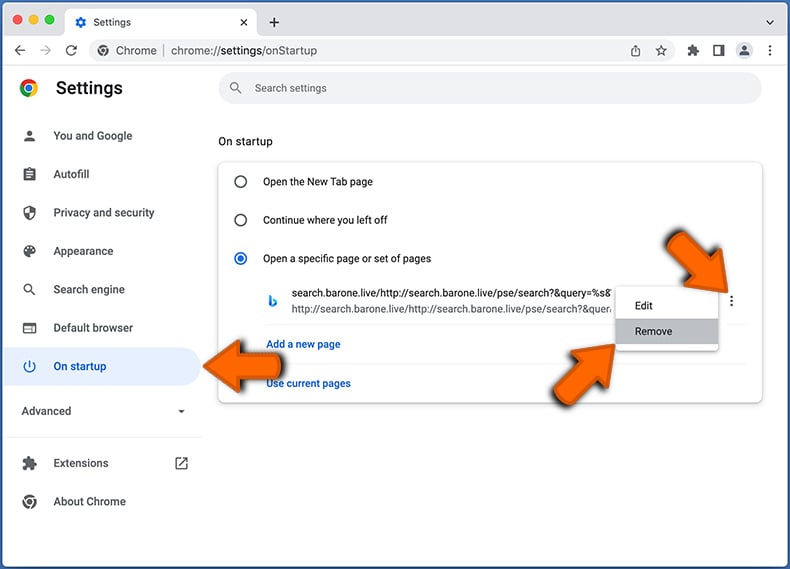
Click the Chrome menu icon ![]() (at the top right corner of Google Chrome) and select "Settings". In the "On startup" section, disable the malicious extension (if present), look for a browser hijacker URL below the "Open a specific or set of pages" option. If present, click on the three vertical dots icon and select "Remove".
(at the top right corner of Google Chrome) and select "Settings". In the "On startup" section, disable the malicious extension (if present), look for a browser hijacker URL below the "Open a specific or set of pages" option. If present, click on the three vertical dots icon and select "Remove".
Change your default search engine:
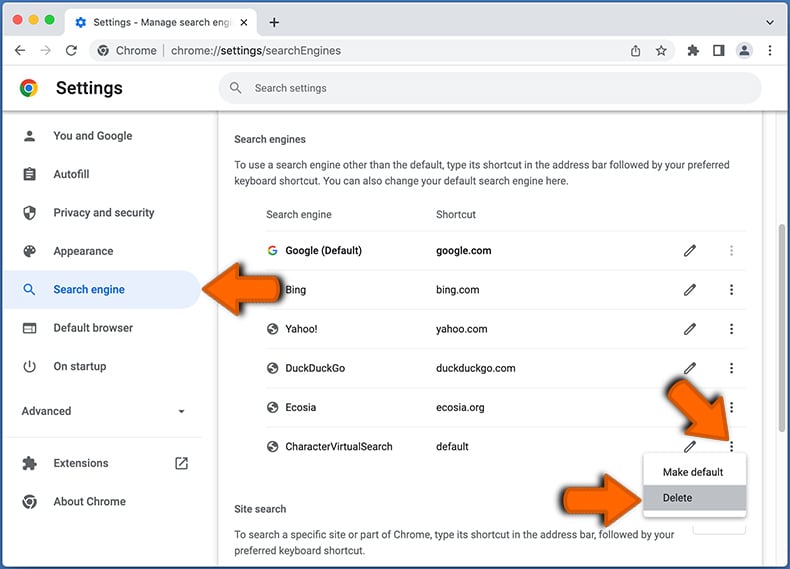
To change your default search engine in Google Chrome: Click the Chrome menu icon ![]() (at the top right corner of Google Chrome), select "Settings", in the "Search engine" section, click "Manage search engines...", in the opened list look for a browser hijacker URL, when located click the three vertical dots near this URL and select "Delete".
(at the top right corner of Google Chrome), select "Settings", in the "Search engine" section, click "Manage search engines...", in the opened list look for a browser hijacker URL, when located click the three vertical dots near this URL and select "Delete".
- If you continue to have problems with browser redirects and unwanted advertisements - Reset Google Chrome.
 Remove malicious extensions from Mozilla Firefox:
Remove malicious extensions from Mozilla Firefox:

Click the Firefox menu ![]() (at the top right corner of the main window) and select "Add-ons and themes". Click "Extensions", in the opened window locate all recently-installed suspicious extensions, click on the three dots and then click "Remove".
(at the top right corner of the main window) and select "Add-ons and themes". Click "Extensions", in the opened window locate all recently-installed suspicious extensions, click on the three dots and then click "Remove".

Change your homepage
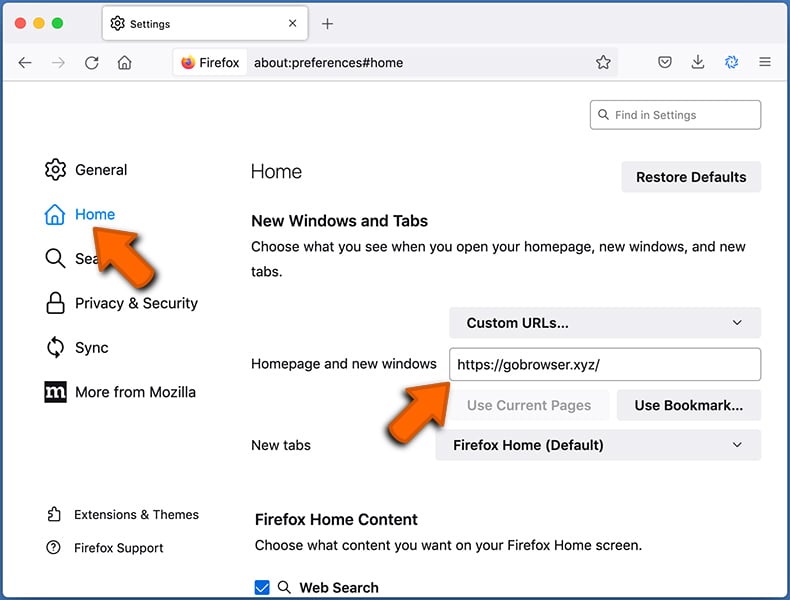
To reset your homepage, click the Firefox menu ![]() (at the top right corner of the main window), then select "Settings", in the opened window disable malicious extension (if present), remove the browser hijacker URL and enter your preferred domain, which will open each time you start Mozilla Firefox.
(at the top right corner of the main window), then select "Settings", in the opened window disable malicious extension (if present), remove the browser hijacker URL and enter your preferred domain, which will open each time you start Mozilla Firefox.
Change your default search engine:
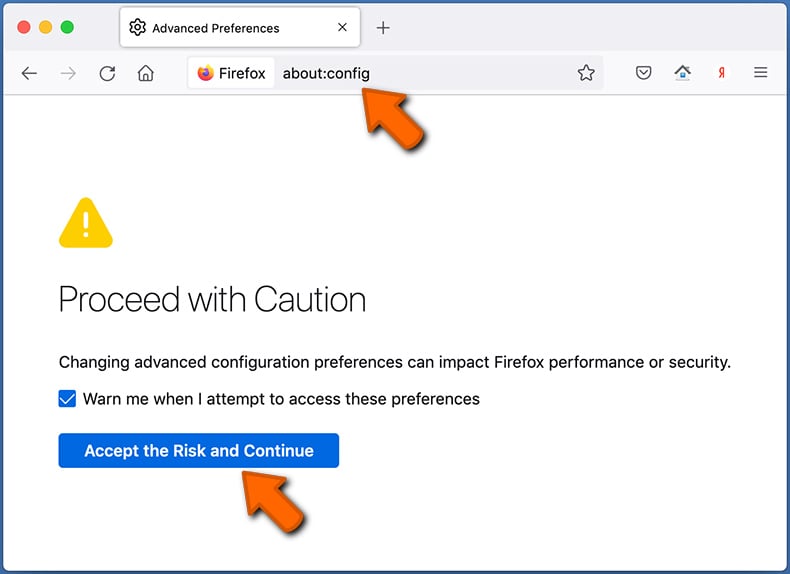
In the URL address bar, type "about:config" and press Enter. Click "Accept the Risk and Continue".
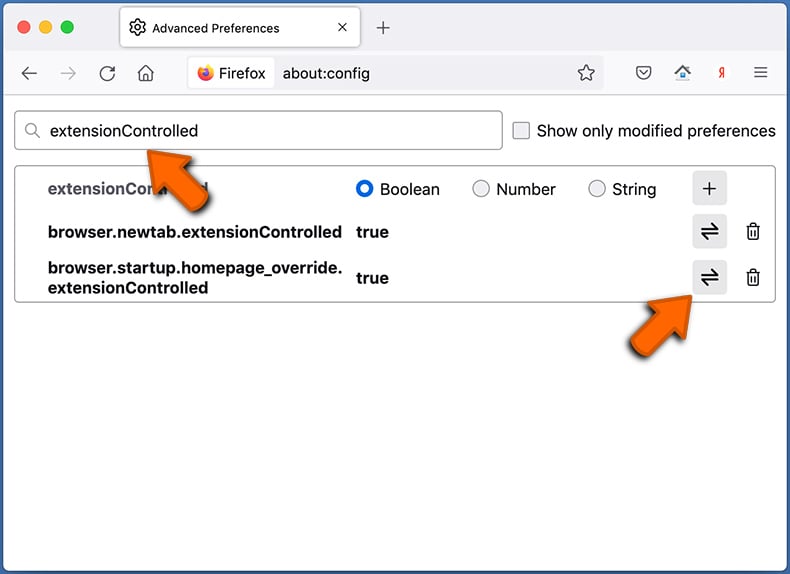
In the search filter at the top, type: "extensionControlled". Set both results to "false" by either double-clicking each entry or clicking the ![]() button.
button.
- If you continue to have problems with browser redirects and unwanted advertisements - Reset Mozilla Firefox.
Share:

Tomas Meskauskas
Expert security researcher, professional malware analyst
I am passionate about computer security and technology. I have an experience of over 10 years working in various companies related to computer technical issue solving and Internet security. I have been working as an author and editor for pcrisk.com since 2010. Follow me on Twitter and LinkedIn to stay informed about the latest online security threats.
PCrisk security portal is brought by a company RCS LT.
Joined forces of security researchers help educate computer users about the latest online security threats. More information about the company RCS LT.
Our malware removal guides are free. However, if you want to support us you can send us a donation.
DonatePCrisk security portal is brought by a company RCS LT.
Joined forces of security researchers help educate computer users about the latest online security threats. More information about the company RCS LT.
Our malware removal guides are free. However, if you want to support us you can send us a donation.
Donate
▼ Show Discussion